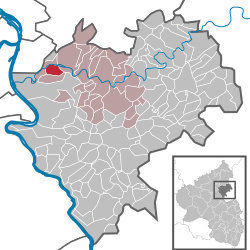Geography
The municipality is located on the south shore of the river Lahn, at Kilometre 128, rising up to the hills of the Taunus mountains. The residential and commercial district of Maaracker, about 1 km to the east, joins directly with the neighbouring town and district capital of Bad Ems. It is then clockwise surrounded by the neighbouring municipalities of Frücht, Miellen and Fachbach on the opposite shore of the Lahn river. Bigger towns nearby include Lahnstein, where the Lahn meets the river Rhine, the catholic Bishopric of Limburg an der Lahn, the old seat of the House of Nassau, Nassau an der Lahn, Montabaur on the ICE high-speed railway between Cologne and Frankfurt am Main and the A3 Autobahn, and the city of Koblenz as the closest regional centre.
History
The area of the modern municipality was incorporated into the Roman Empire by the first century AD and protected by the fortified frontier of the limes, which ran across the Westerwald and Taunus mountains and crossed the Lahn river, the boundary between those, just 5 km to the east in the modern town centre of Bad Ems.
Nievern was first mentioned 1275 AD, although settlement has been suggested from around 900. It was owned by the family of the Von der Leyen since 1629 and then by the Duchy of Nassau since 1806.
During the Second World War, the nearby ironwork Nieverner Hütte, located on an island in the river, served as a production facility for munitions. Bombing raids on the factory and the nearby strategically important cities of Koblenz, Lahnstein and Nassau caused minor destruction and casualties due to accidental collateral damages in the village. Shortly before the municipality was liberated by the U.S. Army on 25 March 1945, the Wehrmacht destroyed both the rail bridge connecting the Lahntalbahn to the ironwork and the first road bridge connecting Nievern with Fachbach dating from 1928. The latter was rebuilt shortly after the war. [3]
This page is based on this
Wikipedia article Text is available under the
CC BY-SA 4.0 license; additional terms may apply.
Images, videos and audio are available under their respective licenses.




